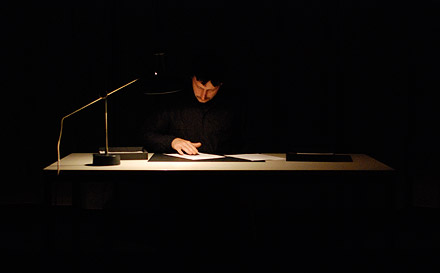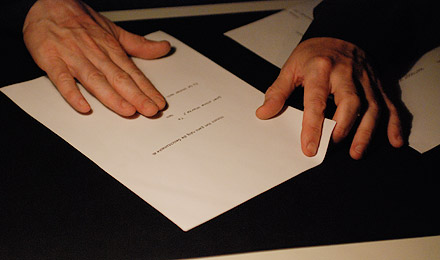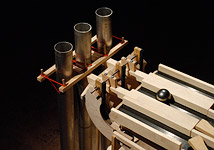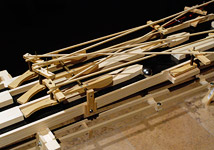Beautiful things at Tesla (which will be shut down after this fall since Berlin has recently decided to kill its funding) last night –

Julien Maire’s Digit, which was also awarded at this year’s Ars Electronica is “a performance that is also conceived to be presented as a piece of living Art. A writer sits at a table writing a text. Simply by sliding his finger over a blank piece of paper, printed text appears under his finger. The spectators can come very close to the ‘writer’ and read the text following the movement of the finger. The writer remains absorbed in his task.” The effect is quite spectacular since the actual mechanism is invisible. He doesn’t give away how it works if you ask him and neither should we.
 Digit
Digit
Maire says that “Digit enlarges the concept of projection and the concept of a project that operates in interstices between literature and moving image as well as referring to the surrealistic tradition of cutting and rearranging text: “Digit” is a kind of Soft machine. In opposition to other types of writing where machine interferes, the human movement is free and can print in any direction. The performance interfaces the human process between the thought and printed word.”
“Thinking Machine”, as opposed to his famous Talking Machine, is artist Martin Riches’ (zero homepage but read an essay on him here) answer to Masahiro Miwa’s proposal to him: “How about a thinking machine = computer? … my dream is to build a very special or unique ‘gate’ … a ”pseudo-random number generator with a simple and elegant algorithm and a long repetition”. Miwa (awesome homepage), who won the Digital Music award at Ars with his Reverse Simulation Music – music that borrows from algorithms and gears to create patterns according to which the sounds are performed – suggested the following: newn = (6 – newn + previousn) mod 3.

 Thinking Machine
Thinking Machine
Martin Riches’ realisation took him 1200 hours to accomplish. “6 large steel balls (4 cm diameter, 250g.) are first loaded by hand into a rotating storage wheel (or shift register), and then its driving motor is started. On leaving the wheel, the balls run down a gentle, 2-meter-long gradient and, on their way, operate various mechanical gates, which pre-determine the course of the following ball, according to the algorithm. Depending on the path taken, they then play one of three percussion instruments: a tubular bell, an instrument similar to a vibro-slap, or an instrument similar to a temple block. They then return to the storage wheel to await their next turn.”
Amazingly, the music that the machine creates is instantly recognizable as coming from the same composer as the utterly hypnotic “Bolero by Muramatsu Gear Engine” which the Brucker orchestra was performing in Linz.
Further niceness included Ignaz Schick‘s “ghosts/vibrations”, 24 speakers “linked to one another with nylon ropes, which are adorned with various small, sounding objects” and a big performance including Christopher Bauder’s electric moOns.
More photos to be found here.
